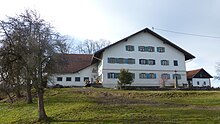Falkensberg Castle Stables
| Falkensberg Castle Stables | ||
|---|---|---|
| Creation time : | probably around 1520 | |
| Conservation status: | no remains of the wall | |
| Place: | Rückholz Castle Courtyard | |
| Geographical location | 47 ° 38 '57 " N , 10 ° 34' 14" E | |
| Height: | 890 m above sea level NN | |
|
|
||
The Burgstall Falkensberg is located above the hamlet of Goldhasen in the municipality of Rückholz .
history
For the first time in 1390 a manor in Falkensberg was named: "Zehenten uz ainem hof haizzet Valkersperg". It was a fief of the bishopric of Augsburg . In 1424 it was owned by Hans Klammer. In 1486, “Walkensperg with its belonging” was owned by Peter Hartung. His son was probably Georg Hartung, who in 1505 had the "Valckensperg with its affiliation" as a fief.
In 1512, Christoph von Ried, citizen and councilor of Feldkirch, was the fiefdom holder. He sold Falkensberg of goods in agouti and sailors to Emperor Maximilian I . Before that, however, the emperor must have owned goods in the small rule of Falkensberg, because in 1501 Stephan Höhenberger, caretaker at Hohenfreyberg Castle , declared that his majesty had delivered a number of goods to golden hares and sailors. Maximilian, who often stayed in the Füssen area, apparently wanted to use Falkensberg as accommodation for his hunts. In 1514 he had the Schwaltenweiher built below the mountain for fishing . By exchanging goods and people, he dissolved the rule of Falkensberg from the high fiefdom. This made the rule a free property with sovereign rights.
In 1515 Maximilian sold Falkensberg with people, farms, fiefs, goods and rivers to Stephan Höhenberger, who probably had a small castle built. He was now called "Steffan von Hohennberg zum Falckensperg". His son Johann von Hohenberg and his wife Anna Kleinhans as well as their son Christoph Friedrich von Hohenberg and his wife Amalie von Knöringen then sold “Schloss und veste zum Falkensberg” with other goods for 17,000 guilders to the imperial city of Kempten in 1588. The inmates of the goods were serfs, judiciary and serviceable to Falkensberg Castle. In 1593 the city had the old castle demolished and a larger and more magnificent castle built by master builder Mathis Heubel from Kempten. She also rebuilt the building yard, the so-called castle yard. The planning for the new building must have started as early as 1590. Popp mentions a document that contains “a thorough description of the Falkensberg Castle, which was rebuilt around this time, and the associated farm buildings”.
But there were difficulties with the bishopric Augsburg because of the sovereign rights and the administration of the "somewhat remote" rule. After sales negotiations with the bishopric were unsuccessful, in 1610 the imperial city left the rule with Falkensberg Castle and all goods, rights and people for 16,000 guilders to the Sankt Mang monastery in Füssen. The monastery incorporated the new property into its office Rückholz and exercised the lower jurisdiction. The high authority that the previous owners had held since the conversion of the feudal lordship into an allodial lordship was also claimed by the Augsburg bishopric. In 1633, Falkensberg Castle was mentioned again in a monastery document, but then it seems to have been destroyed during the Thirty Years' War . The ruin was later used as a quarry, so that only small remains are left. The rule of Falkensberg remained with the St. Mang monastery until its abolition.
description
The former Falkensberg Castle was located about 150 meters east of the castle courtyard, house number 57, on plan number 892/2 of the Rückholz district after the first recording of Bavaria in 1818 .
In the now partly wooded, partly recently overformed area, there are only faint indications of the former castle building with clear ground deformations to the west at the highest point of the site, to the east with a somewhat lower lying area that was probably once built up. Traces of trenches missing, so it probably is only a slightly fortified Ansitz may have acted. In the base of the farmhouse built-in spoilage in the form of cuboid-shaped stones of medium size are visible, but these cannot be safely assigned to the former castle. The Burgstall is characterized by a great panoramic view of the surrounding area.
A plaque on the castle farm has been commemorating the monument since 1932.
literature
- Hans Popp: Falkensberg Castle near Seeg . Alt Füssen, 1938/39 No. 2, p. 74
- Georg Guggemos: Rückholz in the story . Community of Rückholz (ed.) 1963, p. 32 and 50.
- Anton Steichele: The Diocese of Augsburg . historically and statistically described, Volume IV, Augsburg 1883, p. 551.
- Thaddäus Steiner: Historical book of place names of Bavaria . Volume 9 Füssen, Commission for Bavarian State History, Munich 2005, ISBN 3-7696-6861-8 , p. 23.
- Otto Geiger: The documents of the former Benedictine monastery St. Mang in Füssen . Munich 1932.
Individual evidence
- ↑ a b c Thaddäus Steiner: Historical book of place names of Bavaria , Volume 9 feet
- ^ A b Anton Steichele: The Diocese of Augsburg , Volume IV
- ^ Tyrolean Provincial Archives Document I 697
- ↑ City archive Füssen Hopferau registry 1. Part No. 5, fol. 1
- ↑ mentioned in the sales deed of March 9, 1610 (Otto Geiger: The deeds of St. Mang in Füssen , No. 411)
- ↑ a b c Georg Guggemos, Rückholz in der Geschichte
- ↑ St. Mang Füssen Monastery Archives, Fasz.A No. 1a, drawer 26 (copy of the document from 1590)
- ↑ Otto Merkt: Castles, jumps and gallows in the Allgäu . In: Allgäuer Geschichtsfreund No. 52, 1951, p. 97




